Ditapis dengan
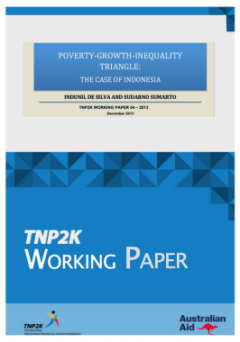
Poverty-Growth-Inequality Triangle: The Case of Indonesia
This paper decomposes changes in poverty into growth and redistribution components, and employs several pro-poor growth concepts and indices to explore the growth, poverty and inequality nexus in Indonesia over the period 2002-2012. We find a ‘trickle-down’ situation, which the poor have received proportionately less benefits from growth than the non-poor. All pro-poor measures suggest that…
- Edisi
- TNP2K Working Paper 04 – 2013
- ISBN/ISSN
- -
- Deskripsi Fisik
- PDF, 41 Halaman
- Judul Seri
- Textbook dan Working Paper
- No. Panggil
- 362.509598 SIL p
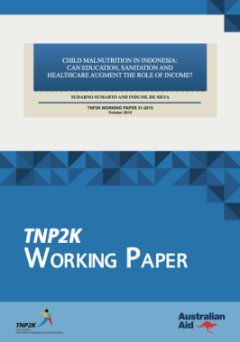
Child Malnutrition in Indonesia: Can Education, Sanitation and Healthcare Aug…
In spite of sustained economic growth and progress in poverty reduction, the status of child nutrition in Indonesia is abysmal, with chronic malnutrition rates continuing to remain at very high levels. In this backdrop, this study attempts to shed light on the channels through which various socioeconomic risk factors affect children’s nutritional status in Indonesia. We investigated the impac…
- Edisi
- TNP2K Working Paper 31-2015
- ISBN/ISSN
- -
- Deskripsi Fisik
- PDF, 51 Halaman
- Judul Seri
- Textbook dan Working Paper
- No. Panggil
- 362.196914 SUM c
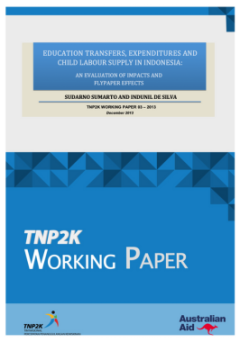
Education Transfers, Expenditures and Child Labour Supply in Indonesia: an Ev…
In this paper we investigate how the receipt of educational transfers, scholarships and related assistance programmes affects the labour supply of children and the marginal spending behaviour of households on children’s educational goods. We use a nationally representative household survey of unusual scope and richness from Indonesia. We found strong evidence of educational cash transfers and…
- Edisi
- TNP2K Working Paper 03 – 2013
- ISBN/ISSN
- -
- Deskripsi Fisik
- PDF, 51 Halaman
- Judul Seri
- Textbook dan Working Paper
- No. Panggil
- 379.509598 SUM e
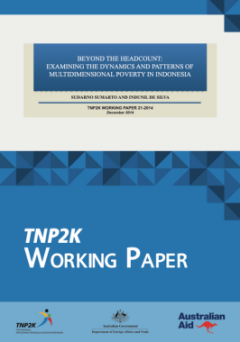
Beyond The Headcount: Examining The Dynamics And Patterns Of Multidimensional…
The aim of this study was twofold. First, although a number of empirical studies exist on income poverty in Indonesia, very few have examined multidimensional household welfare deprivations. We attempted to fill this gap by using for the first time the annually conducted National Socioeconomic Survey by Statistics Indonesia (BPS), and the Alkire and Foster (2007; 2011) methodology to investigat…
- Edisi
- TNP2K Working Paper 21-2014
- ISBN/ISSN
- -
- Deskripsi Fisik
- vii, 44 Halaman, PDF
- Judul Seri
- Working Paper
- No. Panggil
- 361.1 SUD b
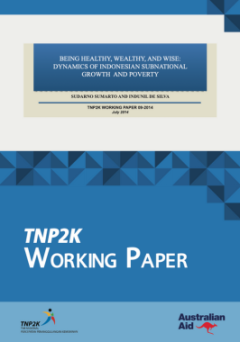
Being Healthy, Wealthy, and Wise: Dynamics of Indonesian Subnational Growth a…
The aim of this study is twofold. First, despite the vast empirical literature on testing the neoclassical model of economic growth using cross-country data, very few studies exist at the subnational level. We attempted to fill this gap by using panel data for 2002–12, a modified neoclassical growth equation, and a dynamic-panel estimator to investigate the effect of both health and education…
- Edisi
- TNP2K Working Paper 09-2014
- ISBN/ISSN
- -
- Deskripsi Fisik
- ix, 37 Halaman, PDF
- Judul Seri
- Working Paper
- No. Panggil
- 362.5 SUD b
 Karya Umum
Karya Umum  Filsafat
Filsafat  Agama
Agama  Ilmu-ilmu Sosial
Ilmu-ilmu Sosial  Bahasa
Bahasa  Ilmu-ilmu Murni
Ilmu-ilmu Murni  Ilmu-ilmu Terapan
Ilmu-ilmu Terapan  Kesenian, Hiburan, dan Olahraga
Kesenian, Hiburan, dan Olahraga  Kesusastraan
Kesusastraan  Geografi dan Sejarah
Geografi dan Sejarah